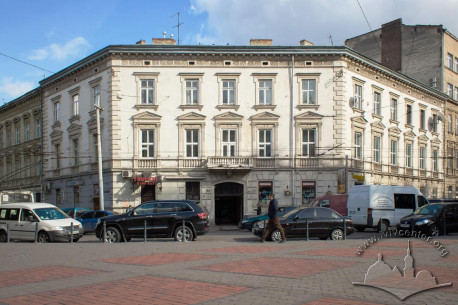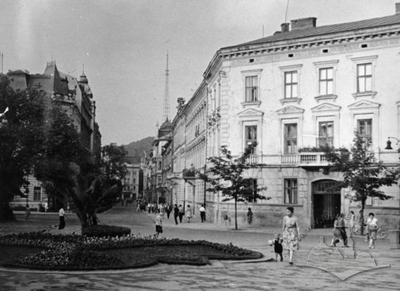Vul. Slovatskoho, 18 – residential building ID: 2421
Former Borkowski townhouse was built according to the project designed by a constructor Emmanuel Gall in 1873–1874. It stood out among other Lviv townhouses of the late 19th c. due to its spacious apartment suites meant for elite residents. The trihedral façade and a complicated layout resulted from the need to adapt to a polygonal parcel. It is an example of Lviv Neo-Renaissance architecture of the 1870s. Presently, it functions as an apartment house with commercial premises on the first floor.
Story
The house was built on the site located in the end of ul. Słowackiego (now vul. Slovatskoho), at the turn towards ul. Majerowska (now vul. Sichovykh Striltsiv). Before the development started, the land plot had been part of the territory of the Jesuit Garden (Franko Park), as owned by the city. In preparations for the construction of the block of buildings of the Galician Diet the adjacent blocks were arranged, such as the road on vul. Slovatskoho was regulated. As a result, a parcel was separated out on the north-east corner of the park, with the conscr. #790 2/4. It was sold to Włodzimierz Borkowski (DALO 2/2/4296:37). The parcel formed the western corner of the quarter between Słowackiego, Majerowska (now vul. Sichovykh Striltsiv), Kostiuszki (now vul. Kostiushka) and Sykstuska (now vul. Doroshenka), and is further divided into three parts. Lateral sites were sold by Waleria Borkowska to other developers (where the houses at vul. Slovatskoho, 16 and Sichovykh Striltsiv, 21 were built). In the central part of the real estate 790 2/4, Borkowska built her own townhouse, №18 on vul. Slovatskoho (DALO 2/1/1092:40,41).
The respective architectural project developed by a constructor Emmanuel Gall was adopted on June, 4, 1873. According to this design, the building was to be of a symmetrical hexagonal shape taking up an area of 673 sq.m. However, in the process of construction, the planned configuration was transformed due to the corrections of the site borders. Therefore, the planning layout became asymmetric. The newly built house received typical features of a tenant townhouse and lost any signs of an upper class residence, thus adapting to architectural formats of a modern city. Additional project design documenting the changes was adopted by the resolution of the magistrate of May, 20, 1874 (DALO 2/2/4296:34-38). In the same year, the construction works on the site were completed.
In the end of 1874, according to Gall's design, the left side wing was extended to place stables, while the right wing was reconstructed to fit a cart shed. Another small extension of the left side wing was initiated by Waleria Borkowska in 1902 (DALO 2/2/4296:40,41).
After the First World War, the townhouse passed into the ownership of the Lviv branch of Warsaw Insurance Society (Warszawskie Towarzystwo Ubezpieczeń). With the new owner, major part of the premises was occupied by large leasehold apartments, while the first floor was taken by administrative and maintenance premises. In 1933, one of the windows on the front facade was reformatted into an office or a store entrance. Some premises on the ground floor have been used since 1934 by a factory of cigarette wrappers (DALO 2/2/4296:15, 21).
Presently, the Borkowski townhouse functions as an apartment house. The ground floor also hosts 2 stores, a copy center, and a café.
Architecture
The building stands on the turn of the street, between the boundary walls of townhouses on vul. Slovatskoho, 16 and vul. Sichovykh Striltsiv, 21. The main façade looks out westward, it faces Ivan Franko Park. The courtyard borders the territories of houses No 8 and 10 on vul. Yuriya Drohobycha.
In the layout, the building has a shape of a deformed horseshoe. The base is V-shaped, with two small asymmetric side wings surrounding a polygonal courtyard. The portal in the center of a frontal block opens a passageway to the courtyard. On the left it has an entrance to the main staircase, rectangular in the layout.
The townhouse is a three-storey building with on a low-rise semi-basement floor. Main frontal block consists of three sections: central and two flanks located angle wise to each other. In the middle of the main façade there is a portal leading to the passageway. Above, there is a balcony with a molded balustrade.
The trihedral western façade has 5 window axes in the middle, and 3 and 6 axes on northern and southern sides respectively. Lower level of the façade wall separated by a narrow cornice is decorated with rustication. Quoins are used on the corners of the façade and on the sides of boundary walls. The 2nd floor windows are flanked with pilasters and have have half-balustrades below them and pediments on top. The 3rd floor windows have cornices instead of pediments. Window openings of upper floors have just trimmings. The façade is topped with a wide entablature with modilions and an embossed ornamental freeze.
The base of the building block has an enfilade layout with 2 chains of rooms. Rear façade has no décor, only balcony galleries along its perimeter. Left side wing, with auxiliary staircase, has a one-storey extension on the side (former stables); while the right side wing has a two-storey extension (former cart shed on the ground floor).
The Neo-Renaissance décor of the townhouse, mainly of the western façade, is dominated by ornamental reliefs with strict and slightly austere in design.
People
Waleria Borkowska — countess, who commissioned the construction of the townhouse on vul.
Slovatskoho, 18.
Włodzimierz Borkowski — count, owner of the parcel with the conscr. # 790 2/4.
Emmanuel Gall — constructor, author of the design of the Borkowski townhouse, and a project design for the left side wing, and the reconstruction of the right side wing.
Sources
- State Archive of Lviv Oblast (DALO) 2/1/1092.
- DALO2/2/4296.


